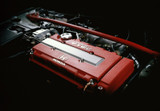After market Exhaust Header Systems Explained, what they do and how they help performance.
After market Exhaust Header Systems Explained, what they do and how they help performance.
Aftermarket headers are a popular performance upgrade. They are designed to improve the flow of exhaust gases out of the engine, which can lead to increased horsepower and torque. In this blog post, we'll take a closer look at how aftermarket headers work and the benefits they can provide your Honda or Acura and beyond.

The exhaust system in a car is responsible for carrying the gases produced by the engine out of the vehicle. The exhaust system is made up of several components, including the exhaust manifold, catalytic converter, and muffler. The exhaust manifold is the first component in the exhaust system, and it is attached to the engine's cylinder head. The exhaust manifold is responsible for collecting the exhaust gases from each cylinder and directing them into the rest of the exhaust system.
Aftermarket headers are a replacement for the factory exhaust manifold. They are designed to improve the flow of exhaust gases out of the engine by reducing backpressure and increasing the diameter of the exhaust piping. This improved flow of exhaust gases can lead to increased horsepower and torque, as well as a more aggressive exhaust note.
One of the key differences between factory exhaust manifolds and aftermarket headers is the design. Factory exhaust manifolds are typically made of cast iron and have a restrictive design that can impede the flow of exhaust gases. Aftermarket headers, on the other hand, are typically made of stainless steel or aluminum and have a more free-flowing design. This free-flowing design allows exhaust gases to exit the engine more efficiently, which can lead to increased horsepower and torque.
Another difference between factory exhaust manifolds and aftermarket headers is the number of tubes. Factory exhaust manifolds typically have one tube for each cylinder, while aftermarket headers often have four tubes, one for each cylinder. This design allows for even more efficient flow of exhaust gases, as there is less chance of exhaust gases getting bottlenecked in the tubes.

In addition to the performance benefits, aftermarket headers can also provide a visual upgrade to a car or truck. They are available in a variety of finishes, including chrome, ceramic-coated, and powder-coated, and can give a vehicle a more aggressive look.
Installing aftermarket headers can be a bit more complicated than installing other performance upgrades, as they require the removal of the factory exhaust manifold. This typically requires the use of special tools, and it is best to have the installation done by a professional mechanic or if you are confident enough and have the right tools, this can be done safely at home as a lot of enthusiasts chose to go this route as well.
Overall, aftermarket headers are a great way to improve the performance of your vehicle. They can increase horsepower and torque, give a more aggressive exhaust note, and provide a visual upgrade. It's a great way to get a little more out of your engine without having to do a full-blown engine swap. However, it is important to note that aftermarket headers may not be legal in all states and could void any vehicle warranty. As always, it's a good idea to check with local laws and regulations before making any changes to your Honda or Acura.
Want to purchase headers for your car? Check out our performance header section!
Recent Posts
-
Honda / Acura Short Shifters: An introduction to what they do and how they work.
Introduction to Honda / Acura short shiftersHello and thank you for checking out our website, we at& …Feb 9th 2024 -
What is VTEC and how does it work? Unlocking the Mystery of the Legendary Roar.
VTEC: Unleashing the Hidden Beast Within Your HondaPop the hood of any Honda sporting the iconic "VT …Dec 17th 2023 -
Hondata Flashpro VS Ktuner: Comparing both systems to find out what works best for your Honda.
Hondata Flashpro VS KtunerHondata FlashPro and Ktuner are two of the most popular tuning systems for …Jan 30th 2023




